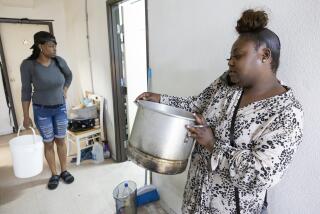Northridge Meadows Dismantling Begins; Ex-Tenants Denied Access
- Share via
The whine of chain saws in the early morning fog Monday marked the start of an autopsy on Northridge Meadows, where 16 tenants died in the Jan. 17 earthquake.
By noon, sections of the roof had been cut away to reveal the guts of the building, and half a dozen lawyers were arguing their cases at a sidewalk news conference.
Former tenants, many from pancaked first-floor units, came to retrieve their belongings and were turned away.
Looking at the place where his mother died--the exposed mattress, the broken walls, the painted letters DB, for dead body--Bill Runnings felt sick to his stomach.
So began the dismantling of Northridge Meadows, the scene of the largest concentration of earthquake fatalities from the Northridge quake and Exhibit A in seven wrongful death and personal injury lawsuits.
“I just want some answer to why this thing happened, so we can move on,” said Runnings, 28, a roofer from Phoenix. He said he was supposed to visit his mother, Karol Runnings, the night she was killed in a quake so powerful that it drove her bed through the wall.
It may take months or years of testing and study before experts can deliver those answers. Even then, a jury probably will have to decide the central issue: whether the collapse of Northridge Meadows was caused by the 6.8-magnitude earthquake, the construction or some combination of the two.
Still, Runnings said, respect has drawn him to his mother’s shattered apartment, where the bed juts out, exposed to the elements. The family photographs are in a box in the closet, still underneath something. His lawyer, Jeffrey Behar, was there to assure that when the time comes, Runnings and his sister, Julie Tindall, 29, will be able to get inside apartment 108.
*
Nearly four months after the quake, Tindall said, “it bothers us to know her stuff is everywhere, and possibly the rats and maggots are getting to it.”
Other former residents were told they must hire attorneys to get inside this week while the experts gather evidence. Later, tenants who hire salvage crews can clear out apartments before the city puts the wrecker’s ball to Northridge Meadows, probably about May 12.
Engineers, other experts and lawyers--about 20 in all, according to one estimate--flocked to 9565 Reseda Blvd. for the court-ordered controlled demolition. The 164-unit building will be taken apart, piece by piece at times, so experts can test and study it to determine whether construction defects caused or contributed to the collapse.
They will be looking at the building’s connections and supports as well as shear walls and other seismic requirements.
The engineers started at the top, cutting away several sections of the roof. At that pace, it could take at least a week before the critical evidence in the 40 flattened first-floor apartments is uncovered.
Attorney Joel Castro, who represents relatives of two women who died, told reporters that his engineers had found evidence of another structural defect: The third-floor shear walls were not fastened to the roof. Castro maintains that the fasteners were required by building codes, and says they distribute seismic forces that play on the walls.
But Allen Tharpe, attorney for owner Shasikant Jogani, said there was no evidence that the latest alleged defect had caused or contributed to the collapse. “After all, the roof didn’t collapse,” Tharpe said.
Castro earlier had alleged other defects: that support pipes in the parking structures were too thin, weaker nails were found where stronger nails were specified in the building plans, joist hangers were smaller than those specified, and floors were supported insufficiently with diagonal strips rather than plywood.
*
Later, Tharpe was encouraged by his experts’ “find”: a long board with nails jutting out. It was evidence to Tharpe that the vertical forces of the quake had picked the building up and put it down eight feet to the north. The nails, he noted, were straight, indicating that powerful vertical forces were at play, not just lateral forces.
Castro also alleged for the first time that Northridge Meadows was not built to code. As an example, he contended that the tuck-in parking slots were 35 feet deep--10 feet deeper than the 1970 building codes allowed.
Tharpe and attorneys for builder Brian Heller disputed that contention.
Jon Mower, Heller’s lawyer, maintained that the complex was built to code. Tharpe said Jogani believed that Northridge Meadows was built to code when he bought it from Heller in 1981, about 10 years after it was constructed.
Still, Tharpe said, California law holds Jogani, and other landlords, liable for damages when people are killed or injured in their buildings. The legal principle is known as “strict liability,” and California is one of just a handful of states to follow it.
Jogani has filed a countersuit against Heller’s construction company, which in turn is likely to sue its subcontractors. In 1991, Jogani was listed as one of Los Angeles’ largest residential landlords, with holdings worth $385 million. He held liability insurance on Northridge Meadows, but no quake insurance. He says the quake and recession have claimed his equity in all his properties.
More to Read
Sign up for Essential California
The most important California stories and recommendations in your inbox every morning.
You may occasionally receive promotional content from the Los Angeles Times.













